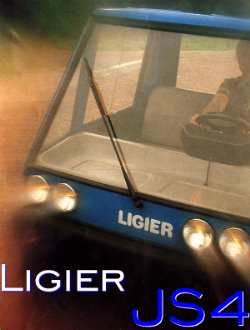


 If you are a Formula One racing fan then you have no doubt heard of the Ligier marque. The F1 machines produced by Automobiles Ligier of Vichy, France have taken part in Formula One events since the mid-seventies and, while never particularly successful, have managed a number of Grand Prix victories. The company, founded by Guy Ligier, teamed up with racing driver Jo Schlesser (who was killed at the wheel of a F1 car only a short time later and his initials graced Ligier products for several years) and also had a go at building sports cars some years past but this did not prove all that profitable. In 1980 Ligier diversified into a completely different market.
If you are a Formula One racing fan then you have no doubt heard of the Ligier marque. The F1 machines produced by Automobiles Ligier of Vichy, France have taken part in Formula One events since the mid-seventies and, while never particularly successful, have managed a number of Grand Prix victories. The company, founded by Guy Ligier, teamed up with racing driver Jo Schlesser (who was killed at the wheel of a F1 car only a short time later and his initials graced Ligier products for several years) and also had a go at building sports cars some years past but this did not prove all that profitable. In 1980 Ligier diversified into a completely different market.
 In 1981 I was at the International Autoshow in Brussels, Belgium (quite possibly at the
Grand Palace, not too far away from the famous
Atomium structure. Among the countless French microcar makers, the Ligier stand, with its blue (French blue?) JS4 on display, grabbed my attention.
In 1981 I was at the International Autoshow in Brussels, Belgium (quite possibly at the
Grand Palace, not too far away from the famous
Atomium structure. Among the countless French microcar makers, the Ligier stand, with its blue (French blue?) JS4 on display, grabbed my attention.
One of the more interesting properties of the JS4, which then represented Ligier's first entry in the competitive European microcar market, is that it can be safely driven in the unfortunate event that one of its tiny wheels falls off. This is accomplished by an extremely well balanced design that involves an evenly matched wheelbase and track width measurement and a centralized center of mass.
The JS4's small engine and 2-speed (+ reverse) gear box are in unit with the rear axle, to which power is transferred by belt. The dimunitive and quite simple 2-person microcar also sports an all steel monocoque construction, fully independent suspension at both ends, and 4-wheel hydraulic brakes. Luggage can be packed in to the respectable rear trunk or can be stowed in the generously deep shelf ahead of the control panel. The powerplant of the JS4, since its originally 1980 introduction, has ranged from a 49cc 2-stroke (presumably 2 cylinders) to a 327cc diesel unit later on in the eighties.
